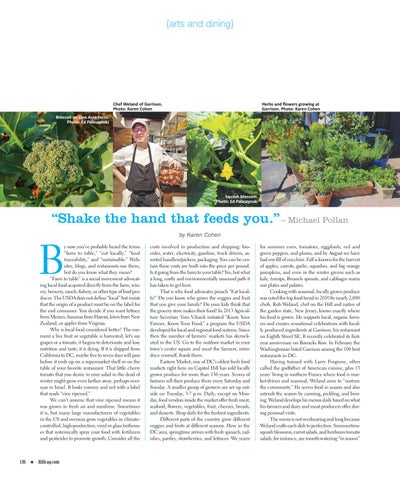{arts and dining}
Herbs and flowers growing at Garrison. Photo: Karen Cohen
Chef Weland of Garrison. Photo: Karen Cohen Broccoli on One Acre Farm. Photo: Ed Palaszynski
Squash blossom. Photo: Ed Palaszynski
“Shake the hand that feeds you.” – Michael Pollan
B
y now you’ve probably heard the terms “farm to table,” “eat locally,” “food traceability,” and “sustainable.” Websites, blogs, and restaurants use them, but do you know what they mean? “Farm to table” is a social movement advocating local food acquired directly from the farm, winery, brewery, ranch, fishery, or other type of food producer. The USDA does not define “local” but insists that the origin of a product must be on the label for the end consumer. You decide if you want lettuce from Mexico, bananas from Hawaii, kiwis from New Zealand, or apples from Virginia. Why is local food considered better? The moment a live fruit or vegetable is harvested, let’s say grapes or a tomato, it begins to deteriorate and lose nutrition and taste; it is dying. If it is shipped from California to DC, maybe five to seven days will pass before it ends up on a supermarket shelf or on the table of your favorite restaurant. That little cherry tomato that you desire in your salad in the dead of winter might grow even farther away, perhaps overseas in Israel. It looks yummy and red with a label that reads “vine ripened.” We can’t assume that vine ripened means it was grown in fresh air and sunshine. Sometimes it is, but many large manufacturers of vegetables in the US and overseas grow vegetables in climatecontrolled, high-production, vinyl or glass hothouses that systemically spray your food with fertilizers and pesticides to promote growth. Consider all the
136 H Hillrag.com
by Karen Cohen costs involved in production and shipping: biocides, water, electricity, gasoline, truck drivers, assorted handlers/pickers, packaging. You can be certain these costs are built into the price per pound. Is it going from the farm to your table? Yes, but what a long, costly and environmentally unsound path it has taken to get here. That is why food advocates preach “Eat locally!” Do you know who grows the veggies and fruit that you give your family? Do your kids think that the grocery store makes their food? In 2013 Agriculture Secretary Tom Vilsack initiated “Know Your Farmer, Know Your Food,” a program the USDA developed for local and regional food systems. Since then the number of farmers’ markets has skyrocketed in the US. Go to the outdoor market in your town’s center square and meet the farmers, introduce yourself, thank them. Eastern Market, one of DC’s oldest fresh food markets right here on Capitol Hill has sold locally grown produce for more than 136 years. Scores of farmers sell their produce there every Saturday and Sunday. A smaller group of growers are set up outside on Tuesday, 3-7 p.m. Daily, except on Monday, food vendors inside the market offer fresh meat, seafood, flowers, vegetables, fruit, cheeses, breads, and desserts. Shop daily for the freshest ingredients. Different parts of the country grow different veggies and fruits at different seasons. Here in the DC area, springtime arrives with fresh spinach, radishes, parsley, strawberries, and lettuces. We yearn
for summer corn, tomatoes, eggplants, red and green peppers, and plums, and by August we have had our fill of zucchini. Fall is known for the harvest of apples, carrots, garlic, squashes, and big orange pumpkins, and even in the winter greens such as kale, turnips, Brussels sprouts, and cabbages warm our plates and palates. Cooking with seasonal, locally grown produce was voted the top food trend in 2010 by nearly 2,000 chefs. Rob Weland, chef on the Hill and native of the garden state, New Jersey, knows exactly where his food is grown. He supports local, organic farmers and creates sensational celebrations with locally produced ingredients at Garrison, his restaurant on Eighth Street SE. It recently celebrated its firstyear anniversary on Barracks Row. In February the Washingtonian listed Garrison among the 100 best restaurants in DC. Having trained with Larry Forgione, often called the godfather of American cuisine, plus 13 years’ living in southern France where food is market-driven and seasonal, Weland aims to “nurture the community.” He serves food in season and also extends the season by canning, pickling, and brining. Weland develops his menus daily based on what his farmers and dairy and meat producers offer during personal visits. The menu is not overbearing and long because Weland crafts each dish to perfection. Summertime squash blossoms, carrot salads, and heirloom tomato salads, for instance, are mouth-watering “in season”
